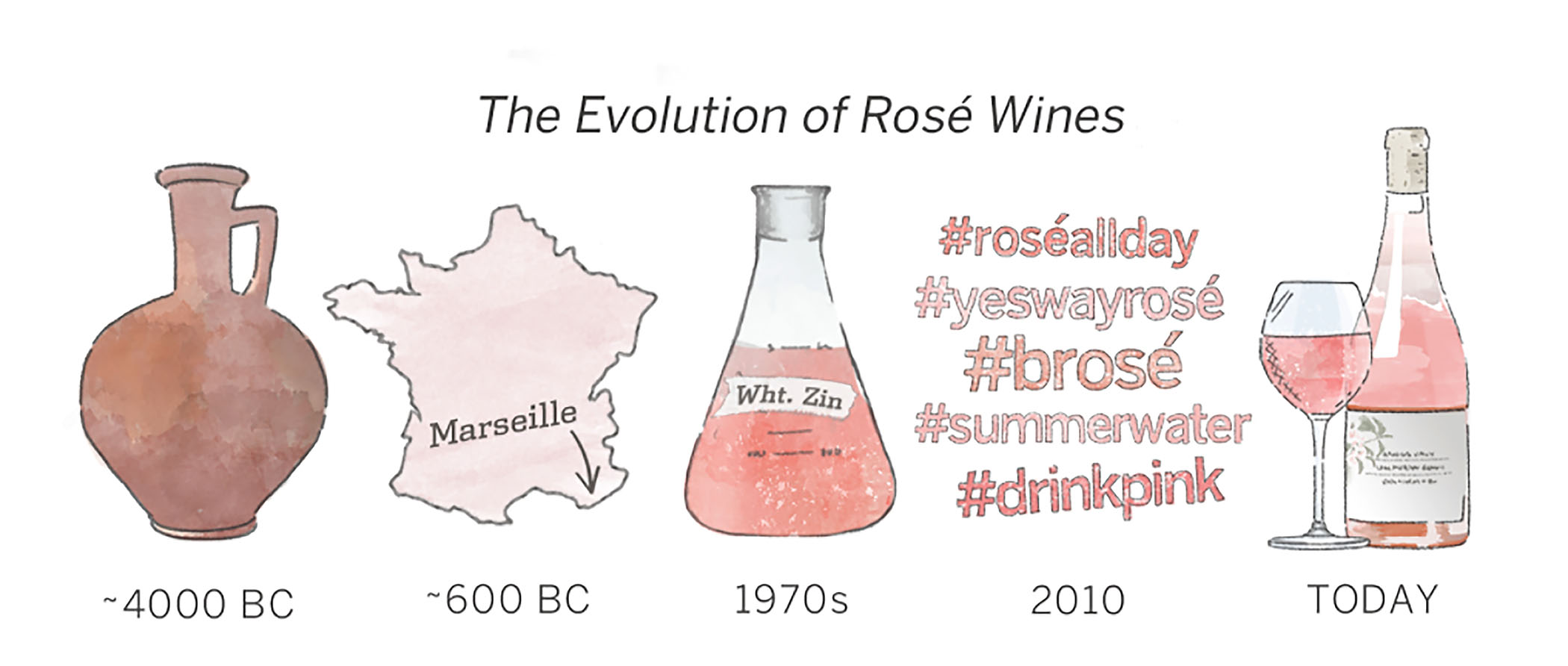The Evolution of Rosé Wines

While Europeans have been making and enjoying pink wine for thousands of years, Rosé didn’t receive much awareness in the United States until the late 19th century. In recent years, social media has revealed a global adoration for Rosé that isn’t going anywhere anytime soon.
ANCIENT ROSÉS
The art of making pink wine is nothing new. Ancient Greeks made wine from red grapes without maceration which would have resembled what we consider Rosé. Not only were red wines light in color, they were often diluted with water, because lighter wines were considered more cultured than darker “pure wines.” Greeks kept their pink wine lifestyle to themselves for centuries, until the 6th century BC when their winemaking techniques and grapevines were introduced to modern-day Marseille. Provençal winemaking has been dominated by Rosé ever since.
THE OFFICIAL WINE OF EUROPEAN VACATIONS
As techniques improved over the years, short maceration was adopted by Provençal winemakers and for centuries their Rosés were traded around the Mediterranean. While more famous for Sancerre, The Loire Valley also has a long history of producing Rosé. And for the most part, pink wines from both Provence and The Loire Valley have always been on the lighter side with a refreshing quality to them. This made them perfect for summer vacations in the 1960s when France introduced mandatory vacation days. Provence and The Loire Valley became very popular places for people to spend time off and Rosé quickly became the official wine of leisure in Europe. At the same time in the United States there was a small population of Rosé fans and the first imported Rosé by Domaines Ott made waves within that circle. Rosé popularity in America continued to rise after Julia Child said “Rosé can be served with anything.” But some wine connoisseurs would need more convincing than that.
A HAPPY ACCIDENT
In 1974, Bob Trinchero’s Sutter Home White Zinfandel was created serendipitously. Fermentation of a wine did not occur as was expected, and the result was a slightly sweet pink wine made from Zinfandel grapes. Sutter Home drinkers loved it and Rosé finally had a strong customer base in the US. It did so well that in 1987, Sutter Home produced over 4.5 million cases of White Zinfandel and at the time was the best-selling premium wine in the United States. In the 1990s, there was an increase in the presence of Rosés on wine lists in popular American restaurants as winemakers started focusing on dry and more balanced expressions. It was a slow climb until pink wine became internet-famous after the turn of the century.
POST-Y2K ROSÉS
National Rosé Day, approved by the National Day Calendar in 2014, was celebrated and talked about online by consumers and celebrities alike. Americans learned about Rosés from around the globe, thanks to social media. In 2015, Erica Blumenthal and Nikki Huganir took full advantage of social marketing when they launched their Rosé brand called Summer Water, using #yeswayrosé on Instagram to increase awareness. Not only has pink wine awareness increased in the last 15 years, it’s quality and diversity have too. We have seen a shift from sweet, simplistic rosés to more dynamic, structured and elegant versions of pink wine. Rosé is adored by wine lovers today to the extent that wineries can sell out of a vintage within a few weeks of its release.
ROSÉ AT LONG MEADOW RANCH
Rosé can be made from many different varietals of wine. At Long Meadow Ranch, we make Rosé from Pinot Noir grown in Anderson Valley. The natural marine layer that blankets these vineyards creates terroir ideal for our estate-grown Burgundian varietals to mature slowly and ripen to the peak of their varietal character. Our Rosé expresses the uniqueness of the loam and cooler climate in this region, and is characterized by a light salmon pink color and bright finish. And, our 2019 Rosé of Pinot Noir is no exception! Winemaker Stéphane Vivier’s goal is to produce balanced, food-friendly Rosé every year. We certainly believe that pink wine has never been better and look forward to every new vintage.
